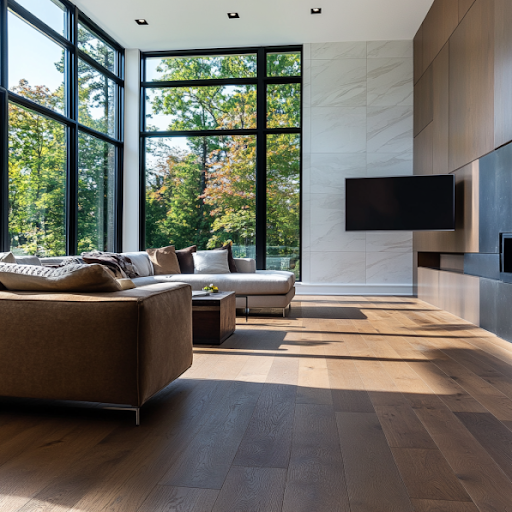
When architects seek to create spaces that breathe life into their visions, custom hardwood flooring and design elements often become the foundation of their creative expression. The artistry of premium hardwood flooring installations transforms spaces into living canvases, where grain patterns dance with natural light and create dynamic interactions between built elements and organic materials.
Nature’s Palette in Architectural Design
Wood speaks a language all its own. Each species brings unique characteristics to architectural spaces – from the bold, dramatic statements of Brazilian Cherry to the subtle, refined presence of White Oak. These natural variations create opportunities for architects to compose spaces that tell compelling visual stories.
Light and Shadow Play
The interaction between hardwood surfaces and natural light creates ever-changing atmospheric effects throughout the day. Morning light might catch the rippling grain of quarter-sawn oak, while afternoon sun transforms wide pine planks into rivers of amber. These dynamic interactions add depth and dimension to architectural compositions.
Spatial Flow and Continuity
Modern architectural design often emphasizes flow between spaces. Thoughtfully designed hardwood installations can guide movement, define zones, and create visual continuity. Innovative installation patterns – herringbone transitioning to straight lay, or subtle shifts in wood tone – can articulate space without interrupting its flow.
Vertical Integration
Contemporary design increasingly incorporates hardwood beyond the floor plane. Wall applications and ceiling treatments create cohesive environments where wood elements envelope space. This three-dimensional approach transforms rooms into immersive architectural experiences.
The Mathematics of Beauty
Behind the artistic impact lies precise geometric planning. Golden ratios inform plank proportions, while Fibonacci sequences guide pattern progressions. These mathematical underpinnings create subconscious harmony that makes spaces feel “right” without revealing why.
Sustainable Aesthetics
Modern architectural applications of hardwood embrace sustainability without compromising design integrity. Reclaimed materials bring historical depth to contemporary spaces, while innovative forestry practices ensure future availability of premium materials.
Climate Considerations
Understanding regional climate variations influences hardware selection and installation methods. Proper consideration of these factors allows architects to specify materials that maintain their aesthetic integrity across seasons and years.
Technical Artistry
The fusion of traditional craftsmanship with modern technology enables unprecedented precision in hardwood applications. Computer-aided design tools help visualize complex patterns, while advanced milling techniques ensure perfect execution.
Material Dialogue
Hardwood’s versatility shines in its ability to complement other architectural materials. Its warmth balances concrete’s coolness, its organic patterns contrast with steel’s uniformity, and its natural tones harmonize with stone’s solidity.
Acoustic Architecture
Often overlooked, hardwood’s acoustic properties contribute significantly to architectural atmospheres. Different species and installation methods can either amplify or soften sound, allowing architects to shape not just visual but auditory experiences.
Future Perspectives
Emerging technologies are expanding hardwood’s architectural possibilities. New treatment methods enhance durability while preserving natural beauty, while innovative finishing techniques offer unprecedented creative freedom.
Design Integration
Strategic hardwood placement can:
- Define circulation paths
- Create visual anchor points
- Establish spatial hierarchies
- Frame architectural features
Cultural Resonance
Hardwood’s timeless appeal transcends trends, allowing architects to create spaces that remain relevant and beautiful across generations. This permanence adds depth to architectural storytelling.
Conclusion
The architectural application of hardwood flooring represents a perfect marriage of form and function. When thoughtfully integrated into design concepts, it becomes more than a surface – it becomes an integral part of the architectural narrative.



